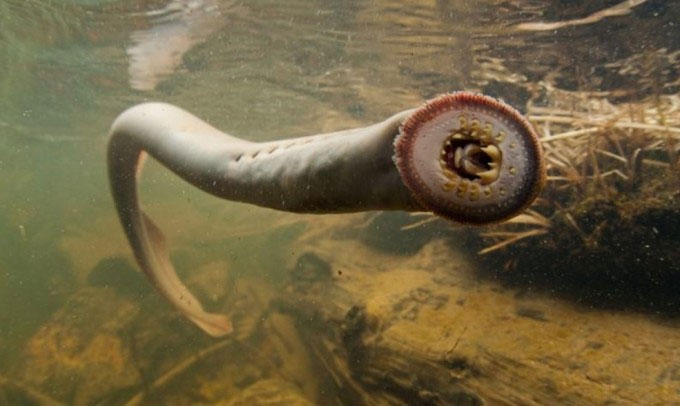Compound Prevents Sucker Fish From Invading the Great Lakes
Lampreys, an invasive blood-sucking species, became a nightmare for fishermen across the Great Lakes until scientists discovered an effective compound to kill them.
Officials are claiming a rare victory over an invasive blood-sucking fish that nearly decimated the $7 billion fishing industry in the Great Lakes. More than a century ago, the Atlantic lamprey, a native of the Atlantic Ocean, entered the Great Lakes through human activity. There, they began devouring local fish, from salmon to lake trout to walleye, according to National Geographic .

Lampreys threaten the entire Great Lakes fishery. (Photo: Washington Department of Fish and Fisheries)
'They basically just swim in. We opened the floodgates for them when we built the canal,' said Greg McClinchey, director of policy and advocacy for the Great Lakes Fisheries Commission (GLFC), an international organization focused on lamprey control. 'We don't fully understand what they're capable of yet.'
A single lamprey can kill up to 40 pounds of fish in the larval stage of its life. Each female lamprey will lay about 100,000 eggs, about 75 percent of which survive. At their peak, they consume more than 100 million pounds of fish, far more than humans, according to McClinchey. They also destroy more natural ecosystems than humans do. Not only are fish in the Great Lakes unprepared to defend themselves against lampreys, the region also lacks natural predators to help control the invasive species.
A decades-long campaign to control invasive lampreys has been an unprecedented success. The key to success is a new chemical called lampricide that kills about 90 to 95 percent of lampreys in the Great Lakes, but leaves endemic species unharmed. The campaign has saved the Great Lakes fishery, according to Marc Gaden, executive secretary of the Great Lakes Fisheries Commission.
The way lampreys hunt is simple. They lack conventional teeth, instead using sharp weapons called tooth plates. Lampreys use their tooth plates to latch onto any fish, then punch holes in the prey's abdomen, creating an open wound. Their saliva prevents the wound from healing, allowing them to continue sucking blood. The result is a very uncomfortable host. When lampreys began their invasion in the mid-20th century, fishermen complained that when they pulled their nets they found so many dead fish that they were holding onto the nets. Lampreys consume fish five times faster than commercial fishing.
In 1954, an agreement between two countries, eight states, a province, and several tribes led to the creation of the GFLC. When local governments tried to control lampreys with dams, electrocution, and even giant screens, but to no avail, they needed a solution that could kill the larvae in the streambed before they could metamorphose into subadults, swim into the lake, and kill native fish. That was the genesis of the lampricide program .
In 1950, scientists at the University of Michigan began working with officials at the Hammond Bay Biological Station on the shores of Lake Huron. They looked at a chemical that would kill invasive fish but not native species. After seven years of testing, comparing the mortality rates of native fish and lampreys injected with the same compound, the researchers discovered 3-trifluoromethyl-4-nitrophenol, or TFM , a compound that invasive fish had not evolved to metabolize.
TFM quickly became the backbone of the GLFC's control program. Teams were assigned to spray TFM in shallow streams where lamprey larvae congregate before moving to deeper waters as adults to hunt. Deep waters remained a refuge for lampreys until the introduction of niclosamide in the 1990s, a poison that sinks to the bottom and targets the riverbed. The current program maintains the same strategy, combined with dams to limit lamprey spread.
After a long Covid-19 hiatus, operations resumed in 2022. Lamprey numbers began to decline. GLFC now kills about 8.5 million lamprey each year. Researchers are also exploring alternatives, including genetic modification and CRISPR.
- Blood-sucking fish slaughtered native creatures in Lake My region
- Strange life form in the Great Lakes
- The extremely poisonous lion fish is invading the Atlantic
- Archaeological evidence of human activity under Lake Huron
- Fish stocking against water pollution in China
- Some fish species live in the harshest place on earth
- Magnets break records of smoking spoons
- Summary of popular freshwater fish species in Vietnam you should know
- Garlic against infection in children
- Great Rift Valley Rift Great Rift
- The lake can hold up to 2,500 shipwrecks
- The phenomenon of 'ice volcano' on the lake
 Animal 'suffering' after hibernation
Animal 'suffering' after hibernation Why do goats climb well?
Why do goats climb well? Scientists were surprised to see chimpanzees eating turtles
Scientists were surprised to see chimpanzees eating turtles Giant catfish died deadly due to drought in Thailand
Giant catfish died deadly due to drought in Thailand